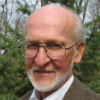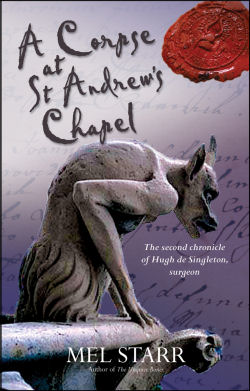
Mel Starr was born and grew up
in Kalamazoo, Michigan. After graduating with a MA in history from
Western Michigan University in 1970, he taught history in Michigan
public schools for thirty-nine years, thirty-five of those in Portage,
MI, where he retired in 2003 as chairman of the social studies
department of Portage Northern High School. Mel and his wife, Susan,
have two daughters and seven grandchildren. He is the writer of The
Unquiet Bones and A Corpse At St. Andrew's Chapel.
|
|
The Genesis of Hugh de Singleton, Surgeon |
|
|
The period from conception to birth for humans is nine months. Gestation for fictional humans may be longer. Master Hugh de Singleton’s genesis required thirty-five years. While teaching middle school history in Portage, Michigan, in the early 1970s, an eighth-grade student asked if I would be interested in seeing a book about the history of the Starr family. I was. This volume was published in 1877, and in it I found my grandfather, Stephen Arthur Starr, born in 1871. I also discovered that the first Starr to arrive in North America was a Puritan “chirurgeon” named Comfort Starr, who settled in Cambridge, Massachusetts, in February 1635 or ’36. This discovery led to an interest in medieval surgical practice. Master Hugh, his name yet unknown to me, had a career. In August 1990, my wife and I made our second visit to England. In the Lichfield Cathedral bookshop I found a medieval mystery that looked interesting: The Virgin in the Ice by Ellis Peters. This book was my introduction to the Brother Cadfael tales. I read the entire series and began to wonder if I might one day do something like it. Master Hugh had found an era. That same evening we sought a B&B in the area and found The Old Rectory in Mavisyn Ridware, a tiny village north of Lichfield. The proprietors, Tony and Lis Page, became friends. We visited them a second time in 1997 and again in 2001. By then they had moved south, to be closer to family and to London and its cultural opportunities. Their new home was in Bampton, fifteen miles west of Oxford. In the fourteenth century the town was the site of a castle with a curtain wall that enclosed one of the largest castle yards in all of England. I recognized that Bampton and its castle would be an ideal setting for the tales I wished to tell. Master Hugh had found a home. The discovery of my Puritan ancestor had sparked an interest in genealogy. I discovered a twelfth century ancestor, Hucca de Singleton, who was lord of the manor of Little Singleton. It seemed to me, when I learned this, that I had heard of the place before. Sure enough. Little Singleton is located in Lancashire, a few miles east of Blackpool and three miles from Great Eccleston. Friends Peter and Muriel Horrocks live in Great Eccleston, and we have visited the place many times. I could create a character from a place I knew well, from an estate where my own ancestor had lived. Master Hugh had a birthplace. Without conflict there is no story. Hugh de Singleton would live in the fourteenth century, “the calamitous fourteenth century” as historian Barbara Tuchman has labeled it. From 1315 to 1318 a famine, caused by excessive rain and cooling temperatures, decimated England’s population. In the 1330s, a dynastic dispute and quarrels over the English king’s land claims in France led to the outbreak of the Hundred Years War. Bubonic plague came to Britain in 1348, returned in 1361, and again in the 1370s. The Peasants Revolt raged through southeastern England in 1381. (Question: Why were the peasants revolting? Answer: They didn’t bathe. Sorry, high school joke.) |
Also during this century came the first stirrings of reform in the church. The Popes lived in Avignon for most of the fourteenth century, and scholars like John Wyclif were suggesting biblical interpretations the bishops considered heretical. So by 2003 Master Hugh de Singleton was nearly fully developed. He would be born about 1340 on the manor of Little Singleton. He would watch family members perish of plague. He would be a younger son, who would not inherit the manor, so he would be sent to Oxford, to Balliol College, where he would study under and become a friend of John Wyclif. Death of a friend in the recurrence of plague in 1361 would bring Hugh a book, Surgery, by Henri de Mondeville. Reading the book would create in Hugh a new interest, and he would go to Paris for a year of study. Returning to Oxford he would find opportunity to treat Lord Gilbert Talbot for a serious leg injury. For this service Lord Gilbert—a real person—would invite Master Hugh to Bampton and offer him the post of bailiff on his Bampton estate. Some authors may be able to rapidly create a protagonist. But Master Hugh was a late bloomer, needing thirty-five years or so to fully develop. Indeed, Hugh is now struggling to solve his fourth mystery, and I am still learning things about the fellow.  |
|
|
|
|
|
|








